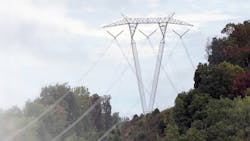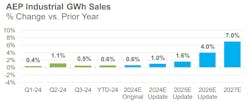American Electric Power Co. Inc. executives have supersized their capital spending forecast by $11 billion from last year’s baseline and—echoing several of their peers—say the Columbus-based company could spend another $10 billion by 2029 to take advantage of strong load growth trends.
Led by new President and CEO Bill Fehrman, AEP leaders expect the company, which has 5.6 million customers in 11 states, will spend $54 billion from 2025 to 2029 to support growth that’s concentrated in Ohio, Indiana and Texas. That’s up from about $43 billion the team had penciled in for the 2024-2028 window, with the growth breaking down as follows:
- Planned spending on distribution is $13.4 billion, up from $11.3 billion
- Transmission projects are in line to get $12.0 billion, up from $9.8 billion in last year’s five-year plan
- The company’s AEP Transmission Holding Co. unit will receive $8.6 billion in capital, up from $6.2 billion
- AEP plans to spend $9.9 billion on regulated renewables, an increase of $500 million
- Regulated new generation projects will get $4.4 billion, a large jump from the $500 million previously allotted to them
Similarly to other utility leaders in recent months, Fehrman said data centers are playing a large role in driving growth and the need for investment. (To that end, AEP’s Ohio utility recently struck an agreement with regulators on a new rate structure for data center operators; that agreement will get a hearing in early December.) Commercial growth is expected to top 23% in 2025 before clocking in between 15% and 20% in the two following years.
"Commercial load has increased more than 10% year-over-year through the third quarter, and our updated sales projections show that pace accelerating,” Fehrman said in AEP’s quarterly earnings report, which showed net income of $960 million on $5.4 billion in revenue. “We expect commercial load to grow an average of 20% annually over the next three years based on customer contracts signed so far. In fact, we now have financial agreements from customers for 20 gigawatts of commercial and industrial load additions through the end of the decade.”
Speaking to analysts on a conference call, CFO Chuck Zebula said the last AEP saw load growth on the level it is forecasting for the second half of this decade was the late 1960s. Hence the need to invest in new generation as well as more wires and substations.
“Based on contract activity across the system, we expect about 20 gigawatts of additional load to come online through the end of the decade,” Zebula noted. “For context, our summer peak load at the end of last year was 35 gigawatts.”
AEP’s earnings report came a few days after Fehrman announced several changes to the company’s leadership team. Most notable among them is the departure of Peggy Simmons, who in August had been named executive vice president of regulatory and chief administrative. Simmons had previously been president of Public Service Co. of Oklahoma and, since 2022, AEP’s EVP of utilities. Fehrman has eliminated her position and moved AEP’s regulatory work, which has run into rough weather several times in recent years, under Zebula.
Also notable among the personnel news: AEP has launched a search for a president of AEP Transmission. The move marks the final step in a strategic turnaround on transmission for the company: Under former CEO Julie Sloat, AEP had considered selling several transmission assets but that plan was shelved early this year when Sloat left the company.
Shares of AEP (Ticker: AEP) fell about 3% to $97 and change on the heels of executives’ earnings report and conference call. They are, however, still up nearly 10% over the past six months, a move that has grown the company’s market capitalization to nearly $52 billion.
About the Author
Geert De Lombaerde
Senior Editor
A native of Belgium, Geert De Lombaerde has more than two decades of business journalism experience and writes about markets and economic trends for Endeavor Business Media publications T&D World, Healthcare Innovation, IndustryWeek, FleetOwner and Oil & Gas Journal. With a degree in journalism from the University of Missouri, he began his reporting career at the Business Courier in Cincinnati and later was managing editor and editor of the Nashville Business Journal. Most recently, he oversaw the online and print products of the Nashville Post and reported primarily on Middle Tennessee’s finance sector as well as many of its publicly traded companies.

